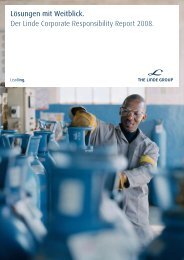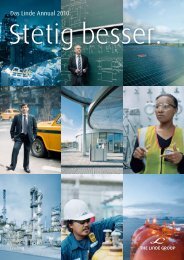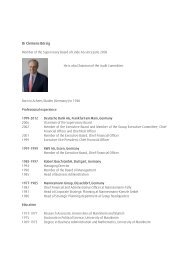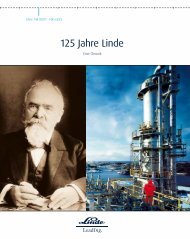The complete history of the development of The - The Linde Group
The complete history of the development of The - The Linde Group
The complete history of the development of The - The Linde Group
You also want an ePaper? Increase the reach of your titles
YUMPU automatically turns print PDFs into web optimized ePapers that Google loves.
1958 1959<br />
General Charles de Gaulle becomes<br />
President <strong>of</strong> France.<br />
Revolution in Cuba under Fidel Castro.<br />
construction <strong>of</strong> a new factory for household refrigerators in<br />
Mainz-Kos<strong>the</strong>im. In 1964, after lengthy discussions, <strong>the</strong> Executive<br />
Board finally decided to merge <strong>the</strong> subsidiaries in Sürth and<br />
Mainz-Kos<strong>the</strong>im with <strong>the</strong> Sürth <strong>Group</strong> (<strong>Linde</strong> Refrigeration).<br />
<strong>The</strong> “white goods” division, meaning refrigerators and chest<br />
freezers for home use, could not be rehabilitated. In 1965 <strong>Linde</strong><br />
finally spun <strong>of</strong>f <strong>the</strong> refrigerator business into an independent<br />
company, which <strong>the</strong>n underwent a majority takeover by AEG<br />
in 1967.<br />
Tractor and engine manufacturing<br />
After a very promising start in <strong>the</strong> post-war period with strong<br />
demand for tractors, Department D (Werksgruppe Güldner, formerly<br />
Güldner Motoren-Gesellschaft) also encountered turbulence.<br />
Although it had to increase capacity in 1951 due to a<br />
growing market share, tractor sales already stagnated <strong>the</strong> following<br />
year. In 1953 Department D reported its first drop in<br />
sales. From this point on until production was ended in <strong>the</strong> late<br />
1960s, tractor manufacturing was plagued with problems.<br />
Nei<strong>the</strong>r <strong>the</strong> new air-cooled diesel engines, which were<br />
introduced in 1954, nor <strong>the</strong> modern production plant opened in<br />
Nilkheim, near Aschaffenburg, in 1956 produced a turnaround.<br />
Even during <strong>the</strong> economic miracle, agriculture was never a<br />
booming sector and <strong>the</strong>re were too many manufacturers in<br />
a very small market.<br />
In order to reduce dependence on agricultural machinery,<br />
<strong>the</strong> management sought “new products,” according to <strong>the</strong> 1957<br />
annual report. <strong>The</strong> next year, Werksgruppe Güldner took over <strong>the</strong><br />
hydraulics division <strong>of</strong> “Gusswerk Paul Saalmann & Söhne OHG” in<br />
Velbert. Toge<strong>the</strong>r with <strong>the</strong> hydrostatic drive, a <strong>Linde</strong> <strong>development</strong>,<br />
N o 1503<br />
Shovel loader with telescoping<br />
mast (Hubtrac).<br />
Advertisement for <strong>the</strong> Güldner Motoren-Gesellschaft in Aschaffenburg.<br />
53




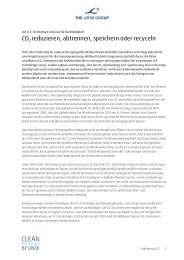

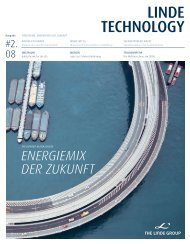

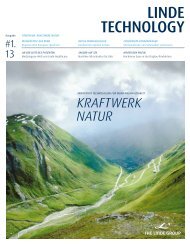

![[41] Anteilsbesitzliste des Linde Konzerns und ... - The Linde Group](https://img.yumpu.com/8356102/1/184x260/41-anteilsbesitzliste-des-linde-konzerns-und-the-linde-group.jpg?quality=85)
![[41] Anteilsbesitzliste des Linde Konzerns und ... - The Linde Group](https://img.yumpu.com/8356076/1/184x260/41-anteilsbesitzliste-des-linde-konzerns-und-the-linde-group.jpg?quality=85)
